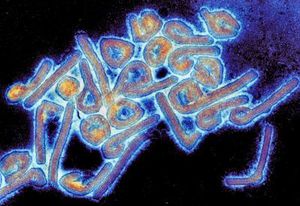Human digestive evolution
Introduction=
Select a topic about genetics or evolution in a specific organism or ecosystem.
The topic must include one section about microbes (bacteria, viruses, fungi, or protists). This is easy because all organisms and ecosystems have microbes.
Compose a title for your page.
Type your exact title in the Search window, then press Go. The MicrobeWiki will invite you to create a new page with this title.
Open the BIOL 116 Class 2019 template page in "edit."
Copy ALL the text from the edit window.
Then go to YOUR OWN page; edit tab. PASTE into your own page, and edit.
At right is a sample image insertion. It works for any image uploaded anywhere to MicrobeWiki. The insertion code consists of:
Double brackets: [[
Filename: PHIL_1181_lores.jpg
Thumbnail status: |thumb|
Pixel size: |300px|
Placement on page: |right|
Legend/credit: Electron micrograph of the Ebola Zaire virus. This was the first photo ever taken of the virus, on 10/13/1976. By Dr. F.A. Murphy, now at U.C. Davis, then at the CDC.
Closed double brackets: ]]
Other examples:
Bold
Italic
Subscript: H2O
Superscript: Fe3+
Section 1 Genetics
Include some current research, with at least one image.
Sample citations: [1]
[2]
A citation code consists of a hyperlinked reference within "ref" begin and end codes.
Perhaps one of the highest-impact short-term genetic digestive change has been the evolution of a Lactase-permanence mutation (LCT). This Lactase permanence mutation, while resulting in a single phenotype, wide can arise from a range of separate SNP's (Single Nucleotide Polymorphisms).
The separate incidences of LCT mutants that were positively selected for vary by region and ethnicity. These range in age from 8,000-9,000 years ago (European Populations) to 2,700-6,000 years ago (African Populations). Howvever, on average, the lactase mutation is present at much lower frequencies in African populations versus European or Middle Eastern populations. This results in higher average rates of lactose intolerance within said population. [3]
Section 2 Microbiome
Include some current research, with a second image.
Recent research suggests that the composition of a person's microbiome may affect their ability to digest lactose to an extent. Though the sample study is notably small (8), it seems that, in part, transplanting certain beta-galactosidase expressing cultures (Such as L. acidophilus) may, in fact, reduce the severity of symptoms. Because of the incredibly early state of research on the topic, it is too early for any definitive trends or statements to be stated with much confidence [4]
Conclusion
Overall text length should be at least 1,000 words (before counting references), with at least 2 images. Include at least 5 references under Reference section.
References
- ↑ Hodgkin, J. and Partridge, F.A. "Caenorhabditis elegans meets microsporidia: the nematode killers from Paris." 2008. PLoS Biology 6:2634-2637.
- ↑ Bartlett et al.: Oncolytic viruses as therapeutic cancer vaccines. Molecular Cancer 2013 12:103.
- ↑ F. Luca et al. "Evolutionary Adaptations to Dietary Changes." 2014. NIHM.
- ↑ Rachel Gingold-Belfer et al., F.A. "Use of a Novel Probiotic Formulation to Alleviate Lactose Intolerance Symptoms— a Pilot Study." 2019. Springer Link 6:2634-2637.
Edited by [Daniel Frank], student of Joan Slonczewski for BIOL 116 Information in Living Systems, 2019, Kenyon College.

